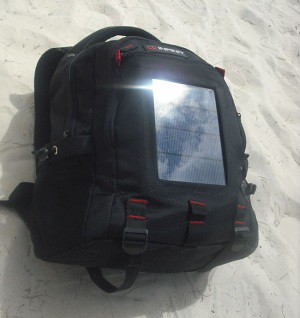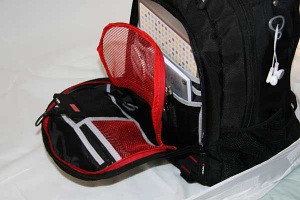My new solar rucksack - the Infinit Solar Charging Bag

I’ve been testing mains-free power solutions for a long time. Since way before the wave of such things being trendy. I’ve always had one ambition. To find something that would keep my mobile phone topped up without me ever needing to resort to mains power. It isn’t, you might think, asking for much. But nothing I’ve tried has been up to the job.
My latest attempt to find a solution is something new for me. A rucksack with a solar panel built into it, the Infinit Solar Charging Bag. This might sound like a rather heavy-handed solution, but it does make quite a lot of sense. The rucksack concept means that in theory you have a power source with you while you are out and about. Take the rucksack on hols for the weekend and it doubles as a daypack and battery. Use it on your daily commute and ditto.
I’m something of a rucksack geek. I’ve done mountain marathons and anyone with similar experience, or who has had to carry all their worldly needs in a bag while trying to get over mountains and through underfoot mud and gunk will sympathise with my desire for perfect ergonomics. Day to day, too, I have separate rucksacks for cycling, for running and for daily use. Again it is all about the ergonomics. Like I said, something of a rucksack geek.

So, the good news is that the Infinite Solar Bag seems is well made. It is a bit on the heavy side when empty due to the thick canvas from which it is made, its solar panel and the battery which gets charged, But it is a nice size with vital statistics of: height 45cm, width 37cm, depth 12cm, capacity 25 Litres, weight 1.4kg.
There is a large main pocket with a separate compartment you could use to carry papers and a small pocket with cable hole for your music player. The primary front pocket is one of those with a network of small pockets and holders inside it. Among them are holders for three pens, a small mesh pocket and a keyring strop. There is space for loose stuff in this pocket too. Behind a red mesh area on the outer side of this pocket is another collection of three pockets, one zipped. This is where the battery lives, and where you can also keep the range of tips that come with it.

There’s another zipped pocket, quite small, on the very front of the bag. Two mesh pockets sit one on each side, one more is on one of the shoulder straps. On the other shoulder strap is a toggle from which you could, if you were so inclined, hang something.
The back cushioning is very good – it is quite solid with an air vent to help reduce that awful rucksack carrier’s sweaty back. There’s a reasonably high quality waist strap too, really invaluable when the load you are carrying is heavy. There is a rain cover, and this lives in a through pocket at the bottom back of the rucksack which can also be used to stow the waist straps.
The solar panel is a photovoltaic cell. It is fairly unobtrusive to look at. The battery to which it is attached by a fixed position USB cable is a 2000mAh cell. You can remove it from the rucksack when you want to use it for charging. You get a mains power charger for the battery and a number of tips for different devices including those appropriate for Blackberry, Nokia Sony Ericsson, Motorola, LG mobile and Samsung handsets as well as a mini USB charging adaptor, Sony PSP Games Console adaptor and Nintendo DS Games Console adaptor. There’s no Apple adaptor but you can use your existing charger as the battery’s power out socket is standard USB.
So, how does it perform?
Well, the bottom line is that I don’t think, in the usual climate of my London home, it is going to keep my phone away from mains power for ever. Hanging the bag up at a window does charge its battery over the course of a sunny day, but on gloomy days it fares less well. I’m not sure about the Web site’s claim that the battery can charge up to two mobile phones from empty, either. Taking my HTC Hero from 55 percent of charge to full completely depletes the battery. I use my Hero every day and over a couple of weeks of testing I’ve found that it needs more juice than the rucksack can provide.
But the good news is that it does work, it produces more power than I’ve got from any other solar device I’ve used, and I am now using it on a regular basis and finding I can avoid about half the mains power charging I was doing before.
Of course this testing has been happening in the midst of some pretty sunny days in London. I’ll be interested to see how it fares when the skies turn gloomy.
And, to that end, I’ll definitely be trying the Infint Solar Charging Bag long term. It will come with me on holidays in sunnier climes, and be used to carry my stuff around when out and about on everyday trips. So it has won me over. But it isn’t a complete solution. I’m still waiting for that.
The Infinit solar Charging bag costs £89.99. More information at www.infinitsolarbags.com